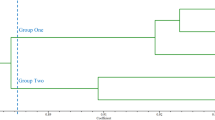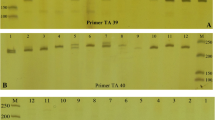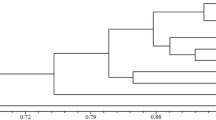Abstract
The public availability of numerous expressed sequence tag (EST) enables EST-based SSR (simple sequence repeat) markers to be widely used for genetics and breeding studies. In the present study, EST-SSR markers were developed from ESTs of Laminaria digitata and were transferred to the non-congeneric species Saccharina japonica. Among the 2,668 non-redundant ESTs, 83 (3.1%) ESTs containing SSR were identified totally, with an average of one SSR per 13.6 kb. Analysis of SSR motifs revealed that the trinucleotide and tetranucleotide were major motifs, accounted for 44.58% and 16.87%, respectively. Based on the 83 ESTs containing SSR, we designed 45 pairs of primers in the flanking regions of the SSR, of which 13 pairs showed polymorphism in a wild S. japonica population, and the mean alleles per locus was 3.6 (ranging from 2 to 6). The observed (Ho) and expected (He) heterozygosities of these EST-SSRs were 0.234–0.632 and 0.260–0.635, respectively. All loci were in Hardy–Weinberg equilibrium in the wild population and no linkage disequilibrium was detected among loci. The obtained EST-SSR markers can facilitate and promote related research such as ecological investigation, genetic diversity assessment and breeding practice of S. japonica as well.
Similar content being viewed by others
Avoid common mistakes on your manuscript.
Introduction
Among different kinds of molecular markers, simple sequence repeats (SSR) have been extensively shown to be useful in plant genetics and breeding due to its high reproducibility, multi-allelic nature, codominant inheritance, relative abundance, and good genome coverage (Powell et al. 1996; Nybom 2004). The major drawback of SSR is that for de novo species, it needs to be developed innovatively. The literature shows that the SSR markers have been mainly isolated from genomic sequences using different methods (reviewed by Zane et al. 2002). While these SSR markers are known as genomic SSRs, there is another type of SSR markers typically referred as EST-SSRs or genic microsatellites, which have been isolated from expressed sequence tags (ESTs), genes and cDNA clones. In contrast to genomic SSR markers, EST-SSR characterizes with some intrinsic advantages: (1) developing the procedure is easy and inexpensive; (2) can be transferable to use in congeneric and non-congeneric species; (3) can be used as functional markers (reviewed by Varshney et al. 2005a). During the past decades with the rapid increasing public availability of numerous EST data, EST-SSRs have gradually shown their validity and function in comparative mapping, functional genomics, gene tagging, QTL analysis and population genetics (Varshney et al. 2005a, b; Ellis and Burke 2007).
Saccharina japonica is a common edible kelp species along the northwest coast of Pacific Ocean (Bartsch et al. 2008). It can be used as food and raw industrial materials for algin, mannitol, and iodine extraction, and also plays an important role in maintaining offshore ecological balance and in bioremediation of marine pollution (Yang et al. 2005; An et al. 2010). Because of its important economic and ecological value, S. japonica is farmed in large scale in western Pacific region. Especially in China, S. japonica aquaculture is a well-developed industry (Tseng 2001; Zemke-White and Ohno 1999). The past decades witnessed considerable interests on ecology, genetics and breeding of this kelp worldwide. Recently RAPD, ISSR and AFLP markers were developed in S. japonica and used for germplasm assessment and identification (Wang et al. 2004), parentage analysis (Billot et al. 1999), genetic diversity investigation (Wang et al. 2005; Yotsukura et al. 2001; Xia et al. 2005), population genetics study (Shan et al. 2011; Bi et al. 2011), genetic mapping (Li et al. 2007; Liu et al. 2009; Yang et al. 2009), QTL analysis (Liu et al. 2010, 2011). However, to date, only a few genomic SSRs and EST-SSR are available for S. japonica (Shi et al. 2007; Liu et al. 2009), although the SSR has already exhibited merits compared to other markers.
To overcome the lack of enough SSR markers, the genomic SSR markers developed by Billot et al. (1998) from Laminaria digitata, one of the species related to S. japonica, were successfully transferred to S. japonica (personal communication). This provides some insights for us that the EST-SSR markers derived from L. digitata also can be transferred to apply in S. japonica. In this study, we developed 13 EST-SSR markers from L. digitata ESTs and testified their transferability in a wild S. japonica population.
Materials and methods
To validate the transferability of EST-SSR markers from L. digitata to S. japonica, a total of 48 wild S. japonica sporophytes were collected on March 17, 2010, from Hokkaido of Japan (N 42°18′, E 140°59′). S. japonica is a brown seaweed; it reproduces sexually by the dioecious gametophytes. As it occurs in sublittoral zone attaching to rocks or other solid substrata, sampling was conducted when the tide is falling. Sporophytes of S. japonica (about 6 cm in width and 70 cm in length) about 2 m apart from each other were randomly collected along the coastline. Small pieces of blade (about 50 g fresh weight) were cut from each individual sporophyte, rinsed with clear seawater and dried quickly by silica gel for future genomic DNA extraction.
EST-SSR identification and primer design
L. digitata EST sequences developed by Crépineau et al. (2000), Roeder et al. (2005), and Cosse et al. (2009) were downloaded from the dbEST database at NCBI, and then preprocessed to exclude redundant EST sequences. Next, SSRIT software (Temnykh et al. 2001) was used to identify SSRs with the criteria of minimum of ten, six, five, four and three repeats for di-, tri-, tetra-, penta- and hexanucleotide motifs, respectively.
Primer pairs were designed in the flanking regions of the SSRs with PRIMER 5.0 software. The parameters for primer design were as follows: product length 150–500 bp (optimum 300 bp), primer size 18–24 bp (optimum 20 bp), primer melting temperature of 50–65°C (optimum 55°C), and none secondary structure.
Genomic DNA extraction and PCR analysis
The genomic DNA was extracted from sporophytes using a Plant Genomic DNA kit (Tiangen Biotech CO., Ltd, China) according to the manufacturer instructions. The polymerase chain reactions (PCRs) were carried out in a total volume of 20 μL containing 0.5 U Taq DNA polymerase (MBI), 1 × PCR buffer, 0.2 mM dNTP mix, 0.5 μM of each primer set, 2.0 mM MgCl2 and about 50-ng template DNA. The mixture was subjected to 94°C for 4 min, following by 35 cycles of 30 min at 94°C, 30 s at annealing temperatures (refer to Table 2), 40 s at 72°C, and a final step at 72°C for 10 min. Amplified products were resolved via 6% denaturing polyacrylamide gel, and visualized by silver-staining according to Bassam et al. (1991).
Statistical analysis
The availability of the identified EST-SSR loci was validated in a S. japonica wild population of 48 individuals. The observed number of alleles (Na), the mean observed heterozygosity (Ho), and the mean expected heterozygosity (He) for each locus in the tested population were calculated by genetic analysis package POPGENE version 1.3 (Yeh et al. 1999). Tests of the Hardy–Weinberg equilibrium and linkage disequilibrium for each locus in the wild population were performed using GENEPOP (Raymond and Rousset 1995).
Results and discussion
Identification and characterization of EST-SSR in L. digitata
A total of 3,124 EST sequences of L. digitata were gathered from the dbEST database at NCBI and 2,668 non-redundant sequences were obtained after preprocessing. Using the SSRIT software, we identified 83 (3.1%) EST sequences containing SSR, with an average of one SSR per 13.6 kb. Some studies showed that 2–11% EST sequences contain SSR in plants (Cordeiro et al. 2001); e.g., maize (1.5%), Medicago truncatula (3.0%), wheat (3.2%), barley (3.4%), rice (4.7%), and sorghum (3.6%) (Kantety et al. 2002. The variation of overall frequency of EST-SSR depends on the criteria used to identify SSRs in the database (Varshney et al. 2005a). Another reason probably is the small number of ESTs explored in our study. It was not convincing statistically to compare the EST-SSR frequency of L. japonica with other plants listed above. Nevertheless, the SSR frequency in ESTs obtained in this study still contains potential references for further study on SSR in L. digitata genome.
Analysis of the results shows that tri- and tetranucleotide repeats were the most abundant types (44.58% and 16.87%, respectively), followed by hexanucleotide repeats (15.66%). Two other types of repeats were detected in the frequency of 12.05% (di-) and 10.84% (penta-), respectively (Table 1). Although the frequencies and distribution of different repeat motifs vary substantially in different species, trinucleotide repeats are the most common, followed by either dinucleotide repeats or tetranucleotide repeats (Varshney et al. 2002; Morgante et al. 2002; Kantety et al. 2002). Our result is also congruent with this general pattern. The abundance of trimeric SSRs in ESTs may be attributed to the absence of frameshift mutations due to length variation in these SSR (Metzgar et al. 2000).
Validation of transferability of EST-SSR marker in S. japonica
Based on the 83 ESTs containing SSR, a total of 45 pairs of primer were designed in the flanking regions of the SSR. Firstly, three individuals were selected randomly and used to test the availability of the designed primers. The results showed that 9 pairs of primer generate no amplified product, whereas 36 pairs of primer could amplify successfully. Among the 36 pairs of primer, 13 pairs gave rise to non-specific amplifications, 23 pairs of primer could produce the unambiguous amplicons, and their sizes were either similar or larger than those of expected amplicons.
One wild S. japonica population containing 48 individuals was used to test the amplified polymorphism of 23 screened pairs of primer. The results showed that 13 pairs could amplify polymorphism in the wild population. Herein, we defined these 13 (56.5%) pairs of primer as EST-SSR loci that could be transferable to use in S. japonica. It has been confirmed that the EST-SSRs show higher transferability to relative species compared to genomic SSRs (Cordeiro et al. 2001; Varshney et al. 2005a, b). This phenomenon may be attributed to the conserved nature of coding sequences in contrast to non-coding sequences. The higher transferability of EST-SSR from L. digitata to S. japonica implied that the two species probably shared the same or similar nucleotide sequence flanking the SSR region. These EST-SSRs markers could produce different number of alleles ranging from 2 to 6 in the wild population, with an average of 3.6 (Table 2). The observed and expected heterozygosities ranged from 0.234 to 0.632 and from 0.260 to 0.635, respectively (Table 2). All loci are in Hardy–Weinberg equilibrium in the wild population and no linkage disequilibrium was detected among loci.
In conclusion, EST-SSR markers from L. digitata were developed and transferred to use in S. japonica. The results showed that 13 markers derived from L. digitata could be across used in S. japonica. These obtained EST-SSR markers will facilitate ecological investigation, genetics study and molecular marker assisted breeding of S. japonica in the future.
References
An XL, Li XM, Xu CX, Li ZX (2010) Ecological effects of seaweeds on the coastal environment. Fishery Sci 29:115–119
Bartsch I, Wiencke C, Bischof K, Buuhholz CM et al (2008) The genus Laminaria sensu lato: recent insights and developments. Eur J Phycol 43:1–86
Bassam JB, Caetano-Anolles G, Gresshoff PM (1991) Fast and sensitive silver staining of DNA in polyacrylamide gels. Anal Biochem 196:80–83
Bi YH, Hu YJ, Zhou ZG (2011) Genetic variation of Laminaria japonica (Phaeophyta) populations in China as revealed by RAPD markers. Acta Oceanol Sin 30:103–112
Billot C, Rousvoal S, Estoup A, Epplen JT, Saumitou-Laprade P, Valero M, Kloareg B (1998) Isolation and characterization of microsatellite markers in nuclear genome of the brown alga Laminaria digitata (Phaeophyceae). Mol Ecol 7:1771–1788
Billot C, Boury S, Benet H, Kloareg B (1999) Development of RAPD markers for parentage analysis in Laminaria digitata. Bot Mar 42:307–314
Cordeiro GM, Casu R, Mcintyre CL, Manners JM, Henry RJ (2001) Microsatellite markers from sugarcane (Saccharum spp.) ESTs cross transferable to erianthus and sorghum. Plant Sci 160:1115–1123
Cosse A, Potin P, Leblanc C (2009) Patterns of gene expression induced by oligoguluronates reveal conserved and environment-specific molecular defense responses in the brown alga Laminaria digitata. New Phytol 182:239–250
Crépineau F, Roscoe T, Kaas R, Kloareg B, Boyen C (2000) Characterisation of complementary DNAs from the expressed sequence tag analysis of life cycle stages of Laminaria digitata (Phaeophyceae). Plant Mol Biol 43:503–513
Ellis JR, Burke JM (2007) EST-SSRs as a resource for population genetic analyses. Heredity 99:125–132
Kantety RV, Rota ML, Matthews DE, Sorrells ME (2002) Data mining for simple sequence repeats in expressed sequence tags from barley, maize, rice, sorghum and wheat. Plant Mol Biol 48:501–510
Li YH, Yang YX, Liu JD, Wang XL, Gao TX et al (2007) Genetic mapping of Laminaria japonica and L. longissima using amplified fragment length polymorphism markers in a “two-way pseudo-testcross” strategy. J Integr Plant Biol 49:392–400
Liu FL, Wang XL, Yao JT, Fu WD, Duan DL (2009) Development of expressed sequence tag-derived microsatellite markers for Laminaria japonica Aresch. J Appl Phycol 22:109–111
Liu FL, Shao ZR, Zhang HN, Liu JD, Wang XL, Duan DL (2010) QTL mapping for frond length and width in Laminaria japonica Aresch. (Laminarales, Phaeophyta) using AFLP and SSR markers. Mar Biotechnol 12:386–394
Liu FL, Yao JT, Wang XL, Hu ZM, Duan DL (2011) Identification of SCAR marker linking to longer frond length of Saccharina japonica (Laminariales, Phaeophyta) using bulked-segregant analysis. J Appl Phycol. 4:709–713
Metzgar D, Jeffrey B, Christopher W (2000) Selection against frameshift mutations limits microsatellite expansion in coding DNA. Genome Res 10:72–80
Morgante M, Hanafey M, Powell W (2002) Microsatellites are preferentially associated with nonrepetitive DNA in plant genomes. Nat Genet 30:194–200
Nybom H (2004) Comparison of different nuclear DNA markers for estimating intraspecific genetic diversity in plants. Mol Ecol 13:1143–1155
Powell W, Machray GC, Provan J (1996) Polymorphism revealed by simple sequence repeats. Trends Plant Sci 1:215–222
Raymond M, Rousset F (1995) GENEPOP (version 1.2): population genetics software for exact tests and ecumenicism. J Hered 86:248–249
Roeder V, Collen J, Rousvoal S, Corre E, Leblanc C, Boyen C (2005) Identification of stress gene transcripts in Laminaria digitata (Phaeophyceae) protoplast cultures by expressed sequence tag analysis. J Phycol 41:1227–1235
Shan TF, Pang SJ, Zhang YR, Yakovleva IM, Skriptsova AV (2011) An AFLP-based survey of genetic diversity and relationships of major farmed cultivars and geographically isolated wild populations of Saccharina japonica (Phaeophyta) along the northwest coasts of the Pacific. J Appl Phycol 23:35–45
Shi YY, Yang GP, Liu YJ, Liao MJ, Li XJ, Cong YZ (2007) Development of 18 polymorphic microsatellite DNA markers of Laminaria japonica (Phaeophyceae). Mol Ecol Notes 7:620–622
Temnykh S, DeClerck G, Lukashova A, Lipovich L, Cartinhour S, McCouch S (2001) Computational and experimental analysis of microsatellites in rice (Oryza sativa L.): frequency, length variation, transposon associations, and genetic marker potential. Genome Res 11:1441–1452
Tseng CK (2001) Algal biotechnology industries and research activities in China. J Appl Phycol 13:375–380
Varshney RK, Thiel T, Stein N, Lanqridge P, Graner A (2002) In silico analysis on frequency and distribution of microsatellites in ESTs of some cereal species. Cell Mol Biol Lett 7:537–546
Varshney RK, Graner A, Sorrells ME (2005a) Genic microsatellite markers in plants: features and applications. Trends Biotech 23:48–55
Varshney RK, Sigmund R, Börner A, Korzun V, Stein N, Sorrells ME, Langridge P, Graner A (2005b) Interspecific transferability and comparative mapping of barley EST-SSR markers in wheat, rye and rice. Plant Sci 168:195–202
Wang XL, Yang YX, Cong YZ, Duan DL (2004) DNA fingerprinting of selected Laminaria (Phaeophta) gametophytes by RAPD markers. Aquaculture 238:143–153
Wang XL, Liu CL, Li XJ, Cong YZ, Duan DL (2005) Assessment of genetic diversities of selected Laminaria (Laminarales, Phaeophta) gametophytes by inter-simple sequence repeat analysis. Integr Plant Biol 47:753–758
Xia P, Wang XL, Li XJ, Zhao YS, Yao L et al (2005) Genetic study of kelp “901” strain. Chin J Oceanol Limnol 23:152–157
Yang YF, Song JM, Lin XT, Nie XP (2005) Seaweed cultivation and its ecological roles in coastal waters. Mar Environ Sci 24:77–80
Yang GP, Sun Y, Shin YY, Zhang LA, Guo SS, Li B, Li X, Li Z, Cong Y, Zhao Y, Wang W (2009) Construction and characterization of a tentative amplified fragment length polymorphism-simple sequence repeat linkage map of Laminaria (Laminariales, Phaeophyta). J Phycol 45:873–878
Yeh FC, Yang RC, Boyle T (1999) POPGENE version1.32, Microsoft window-base software for population genetic analysis: a quick user’s guide. University of Alberta, Center for International Forestry Research, Alberta, Canada
Yotsukura N, Kawai T, Motomura T, Ichimura T (2001) Random amplified polymorphic DNA markers for three Japanese Laminaria species. Fisheries Sci 67:857–862
Zane L, Bargelloni L, Patarnello T (2002) Strategies for microsatellite isolation: a review. Mol Ecol 11:1–16
Zemke-White WL, Ohno M (1999) World seaweed utilization: an end-of-century summary. J Appl Phycol 11:369–376
Acknowledgments
This work was supported by NSFC (no. 40976085), Agriculture Science & Technology Achievements Transformation Fund (2011 GB24910005), Shandong Natural Science Foundation (ZR2010CQ027) and the special fund for basic research of the Yellow Sea Fisheries Research Institute Chinese Academy of Fishery Sciences (20603022012014). We thank Doctor Gang Fu for the sample collection and Doctor Zimin Hu for language revision. The authors also wish to thank the anonymous reviewers for suggestions to this paper.
Author information
Authors and Affiliations
Corresponding author
Rights and permissions
About this article
Cite this article
Liu, F., Wang, F. & Duan, D. EST-SSR markers derived from Laminaria digitata and its transferable application in Saccharina japonica . J Appl Phycol 24, 501–505 (2012). https://doi.org/10.1007/s10811-012-9807-3
Received:
Revised:
Accepted:
Published:
Issue Date:
DOI: https://doi.org/10.1007/s10811-012-9807-3




